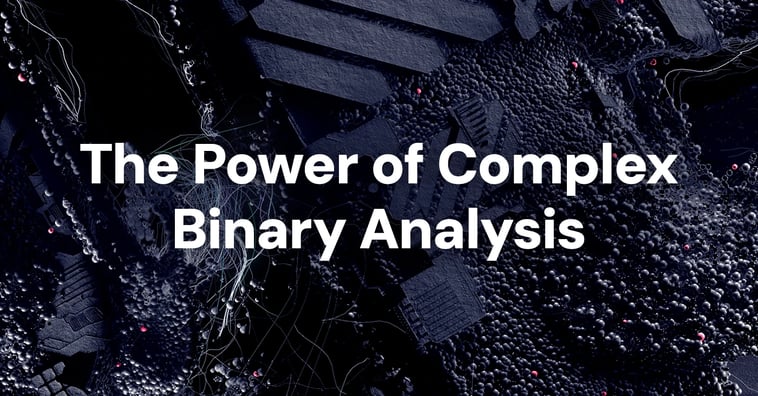ReversingGlass
Report

The Power of Complex Binary Analysis
Learn moreBlog

Complex binary analysis is a cybersecurity methodology that examines software binaries without executing them. This technique scrutinizes compiled programs' structure, dependencies, and behaviors to unearth hidden malware, tampering, vulnerabilities, and other security risks.
Early threat detection: Unveiling risks in advance - Complex binary analysis excels in unearthing vulnerabilities and potential threats lurking within software binaries before they are released or deployed. By meticulously dissecting the binary, security experts can identify weak points, exploitable patterns, and hidden vulnerabilities that malicious actors could leverage. This proactive approach empowers organizations to preemptively address security concerns and take corrective measures before the software reaches its end-users. This minimizes the risk of attacks and bolsters the overall security posture.
Comprehensive review: Peering into the binary landscape - Complex binary analysis entails in-depth scrutiny of entire codebases, leaving no stone unturned to unearth potential threats. This encompassing approach goes beyond just examining the primary code and extends to analyzing third-party components and libraries integrated into the software. By comprehensively assessing the code's interdependencies and interactions, security professionals can identify vulnerabilities that might not be evident through other forms of analysis. This panoramic view of the software's binary structure empowers organizations to understand their software's security landscape thoroughly.
Enhanced compliance: Aligning with regulatory frameworks - In an era of stringent regulatory standards and security benchmarks, complex binary analysis emerges as a formidable tool for ensuring compliance. By subjecting software binaries to rigorous code analysis, organizations can identify and rectify security shortcomings that could lead to non-compliance with industry regulations. This approach helps organizations adhere to industry standards and demonstrates a commitment to robust cybersecurity practices. This, in turn, safeguards customer trust and preserves the organization's reputation.
Malware - Identify malware embedded in proprietary, commercial, or open source code, as well as any build artifacts or components. Should be via threat intelligence to prevent advanced threats from spreading throughout the software supply chain.
Tampering - Stop the ship as soon as the application changes in a suspicious way, or when a reproducible build fails verification. Detect code tampering before the software package leaves the build environment and has a chance to impact production or downstream customers.
Secrets - Discover exposed secrets that made their way into the final build, evading the tools that scan source control for their presence. Validate leaked secrets by testing them against services that they access, and see when they get publicly shared. Prioritize revocation of internal secrets with threat intelligence that automatically suppresses secrets commonly shared in open-source and third-party packages.
Vulnerabilities - Reduce security team fatigue with intelligent vulnerability prioritization. Focus the remediation efforts by patching the vulnerabilities actively exploited by threat actors before shipping. Be sure that all instances of vulnerable code have been patched by relying on differential analysis that summarizes issues resolved and introduced between subsequent software versions.
Risk mitigation - Identifies software software supply chain threats and exposures before release or deployment, enabling organizations to ensure software is trustworthy.
Brand reputation - Avoid long-term negative impact of software attacks on stock value, product trust, and brand perception to both your organization and customers.
Regulatory compliance - Ensures adherence to industry regulations and cybersecurity standards.
Competitive edge - Differentiate by offering secure software that meets user expectations.
Incorporate in SDLC - Integrate complex binary analysis into the software development lifecycle (SDLC) to manage risks before release or deployment.
Automate analysis - Leverage automated tools to streamline the analysis process and identify threats efficiently.
Continuous monitoring - Analyze software updates to detect new vulnerabilities and threats emerging over time.
Software development: Delivering trustworthy software - In software development, complex binary analysis is a pivotal practice for enhancing software security.. By addressing threats, exposures and vulnerabilities before release or deployment, security professionals mitigate software risks and strengthen its defenses before reaching end users.
This early detection eliminates the rush for post-deployment patching, conserving time, resources, and energy. Incorporating complex binary analysis into the development process acts as a robust shield, ensuring the software's integrity and resilience against emerging cyber threats.
Third-party components: Safeguarding through scrutiny - In the modern software landscape, while third-party libraries and components are frequently used to enhance functionality and speed up development, they risk introducing security vulnerabilities. Complex binary analysis becomes vital in this context. Before integrating third-party components, organizations must assess these elements using complex binary analysis rigorously. Security experts can unearth and address potential security flaws and vulnerabilities by scrutinizing the binary code. This ensures that only secure components are integrated, preventing potential compromises to the software and protecting the organization's reputation. In effect, complex binary analysis is a vigilant gatekeeper in software development.
Malware detection: Unveiling concealed threats - In cybersecurity, detecting malware is paramount to prevent system damage and data breaches. Complex binary analysis is central to this effort, allowing the detection of hidden malware signatures and malicious segments within software binaries. Through an in-depth examination of the binary code, security experts can identify and neutralize known malware patterns before they execute. This proactive approach not only counters potential threats but also strengthens an organization's defense against the persistent danger of malicious code.
Complex binary analysis serves as a cornerstone in cybersecurity, offering a proactive approach to threat mitigation. By uncovering vulnerabilities, mitigating risks, and enhancing software security, organizations can bolster their defenses and maintain a robust digital posture in the face of evolving cyber threats. Embrace this methodology to ensure a robust and secure digital environment.
For further insights into complex binary analysis and its implications, explore the following articles:


